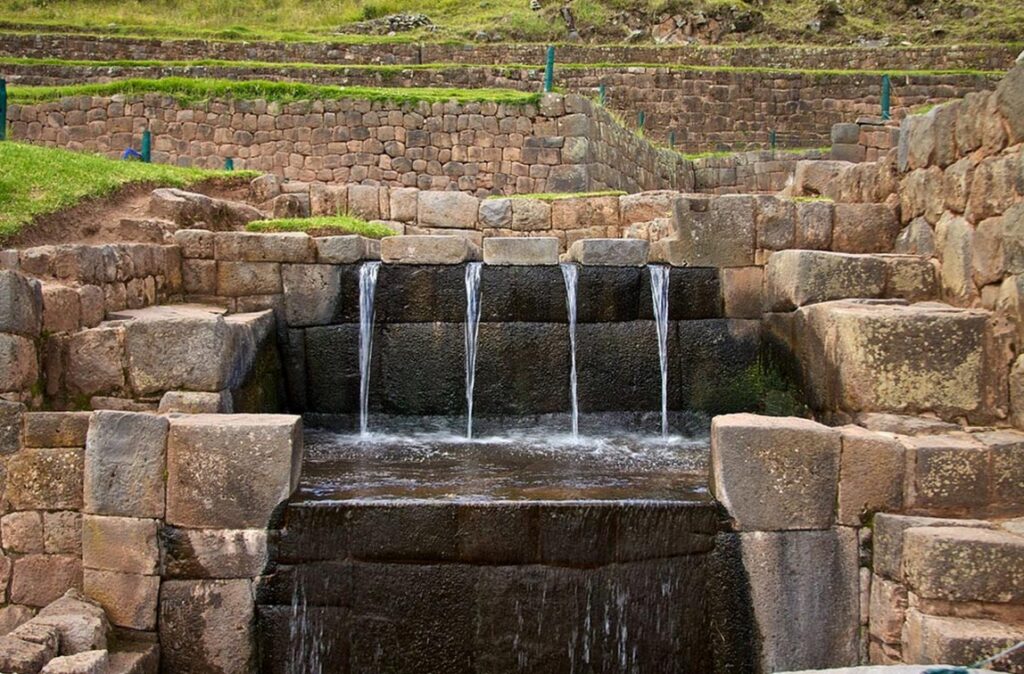
Tipón is one of the most captivating archaeological sites in Peru and reflects the awe-inspiring accomplishments of the Inca Empire. While traces of occupation at Tipón date back thousands of years, its most impressive development occurred about 500 years ago, when it became a self-contained walled settlement that served as an estate for Inca nobility. Inside the settlement lay beautiful royal rooms, canals, plazas, aqueducts, and great water fountains, which all but turned a remote mountainside into an engineering marvel. It was also a place for ceremonial and religious purpose. Today, some of these structures still exist and stand as a testament to the Inca’s mastery of irrigation and hydraulic technology.

The spectacular site of Tipón, Peru (Wikimedia Commons)
The Inca Empire once occupied a vast region centered and around the capital of Cusco, in modern day southern Peru and existed for over a century. It extended across parts of Colombia, Ecuador, Peru, Bolivia, Chile, and Argentina and was the largest empire in pre-Columbia America. The Inca were skilled engineers and craftsmen who built a network of roads linking the distant provinces of the empire together, as well as sophisticated water collection systems for harvesting rainwater, groundwater, and natural springs. Nowhere is this technology more beautifully preserved than at the ancient site of Tipón.

A water spout in Tipón (Wikimedia Commons)
According to legend, the origins of Tipón can be traced to one of the royal gardens that Viracocha, the supreme God of the Incas, ordered to be built. Since the language of the Incas was not a written one, it is impossible to know the exact meaning of the word. However, some believe the origin may come from the Quechua word Timpuj which means “to be boiling”, and relates to the water flowing out of the fountains as though liquid was boiling. Others say Tipón could have been the Royal House of Yahuar Huaca, who retreated here after being defeated by the Chancas.
Tipón is located 25 km from Cusco in a ravine high above the Cusco Valley, ranging in elevation from 10,700 to 13,000 feet. The highest point, Cruzmoqo, once served as a military observance post and place of religious significance, and mysterious ancient petroglyphs from 2000 BC still decorate the volcanic rock there. While the Inca constructed the sophisticated settlement in Tipón in around 1400 AD, the site’s prehistoric importance is well established and can be traced back to between 6,000 and 4000 B.C.

The many-leveled terraces of the Tipón Incan agricultural site. (Wikimedia Commons)
The site of Tipón is made up of thirteen terraces flanked by polished stonewalls, enormous agricultural terraces, canals, and decorative waterfalls. Every archaeological complex features well-built canals which channeled and distributed water throughout the settlement. There are various baths and irrigation channels that still function today, providing the archaeological site with an endless stream of running water. The outer wall at Tipón, measures 15 to 20 feet high and nearly four miles long ,encircling the entire community. This wall also provides evidence that a large labor force was once used, representing a major construction achievement in and of itself. However, evidence points to it being built by an earlier people who pre-dated the Incas.

Today, many of the water channels at Tipón are still functional (Wikimedia Commons)
During the earlier period of the Incas, palaces, temples and fortresses were built. They designed buildings, waterworks, and large structures to be visually and functionally in touch with the natural environment around them. In planning a place that would integrate water, soil, agriculture, and topography together, the Inca created a water garden at Tipón. One of the best examples of their advanced hydraulic engineering constructions is at the Tipón Inca Palace. It has been built in the imperial Inca style and has trapezoidal doors which are serviced by finely cut stone fountains similar to those found at Machu Picchu. These large structures were created from massive tight fitting stones.

An old Inca house at Tipón (Wikimedia Commons)
The lower sector of the Tipón ruins is comprised of a series of agricultural terraces, watered by stone-lined channels, all of which are preserved today. At the back of the lower ruins, water flows from a stone-faced “mouth” around a spring which is probably an aqueduct diverted underground from above. The entire complex is designed around this spring and reached by a path from the last terrace. Another sector of the ruins contains a reservoir and temple block centered on a large, exploded volcanic rock which is thought to be some kind of huaca (temple) or burial place. Off the back of the reservoir, a large stone aqueduct crosses a small crevasse before continuing uphill to an area of unexcavated terraces and dwellings. Beyond these, exist another level of the upper valley covered in Inca terracing, dwellings and stone storehouses. Similar in size to the lower ruins, they are used by locals today who have built their own houses among the ruins.

Water channel at Tipón (Wikimedia Commons)
Tipón was a settlement which was not built overnight but whose technology and culture was drawn from much earlier Andean civilizations and can be traced back many millennia. Millions of people once lived within the confines of the Inca empire and of these, a few settled at Tipón during the reign of the Inca. With the arrival of the Spanish and the collapse of the empire, Tipón was not entirely abandoned and was used by the Quechua Indians, the direct descendants of the Inca. Today, it lies in the heart of what is known as the Sacred Valley. This area was considered sacred in Inca Times because of the astronomical relation with the Milky Way which, at certain times of the year, arcs high above the picturesque valley.